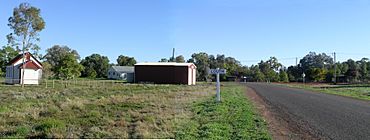Louth, New South Wales facts for kids
Quick facts for kids LouthNew South Wales |
|
|---|---|
 |
|
| Population | 43 (2016 census) |
| Postcode(s) | 2840 |
| Elevation | 100 m (328 ft) |
| Location | |
| LGA(s) | Bourke Shire |
| County | Yanda County |
| Parish | Dunlop Parish |
| State electorate(s) | Barwon |
| Federal Division(s) | Parkes |
Louth is a small village in New South Wales, Australia. It sits on the eastern side of the Darling River. Louth is part of the Bourke Shire. It is about 99 kilometres (62 mi) southwest of Bourke. It is also 132 kilometres (82 mi) northwest of Cobar.
Louth is well-known for its annual Louth Races. These exciting horse races happen every August. They attract large crowds, sometimes nearly five thousand people! In the 2021 census, Louth and the areas around it had a population of 74 people.
History of Louth
Louth began as a small settlement in 1859. An Irish immigrant named Thomas Andrew Mathews started it. He came from County Louth in Ireland. Thomas built a pub to serve people travelling along the busy Darling River.
Growth of the Village
Over time, Louth grew quite a bit. It once had three hotels and a factory that made cordial drinks. There were also three bakeries and two butchers. The village had a post office, three churches, and even a Chinese garden. A general store and a police station also served the community. Today, the old post office has been beautifully restored.
The Unique Headstone
Thomas A. Mathews' first wife, Mary Mathews, passed away in 1886. Thomas had a very special headstone built for her. This unique cross is now an important Australian National Monument. Every evening at sunset, the cross reflects the sun's light. It shines across the town like a bright beacon. On the anniversary of Mary's death, this light perfectly shines on the spot where her family home once stood.
World First Shearing
In 1888, something amazing happened near Louth. The very first time sheep were shorn using machines anywhere in the world took place here. This happened at Sir Samuel McCaughey's Dunlop Station. A station is a very large farm, usually for sheep or cattle. This historic event changed how sheep farming was done forever.


